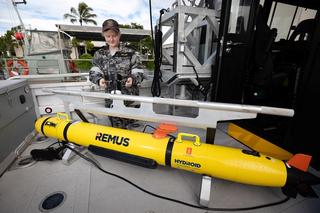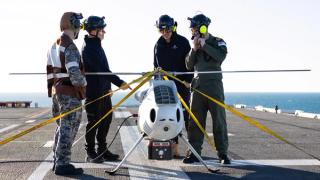Introduction
The US defence industrial base (DIB) is both a national and international strategic asset, and has been the subject of considerable study by both government and non-government analysts for decades. Encompassing all of the organisations and facilities that provide the US military with materials, products, and services, three recent developments, in particular, have heightened this scrutiny:
- the shift in focus of the 2022 US National Defense Strategy (NDS) to near-term peer competition with China;
- the disruptions caused by the national and international response to the COVID-19 pandemic in 2020 and 2021; and
- the ongoing effort to provide significant material support to Ukraine in its conflict with Russia.
The 2022 NDS rests squarely on the assumption that the United States depends on, and will support, its allies and partners. Likewise, there is a shared perception among the United States and its key allies, including Australia, that threats to the ‘rules-based international order’ (primarily from China) will emerge relatively soon (Australia’s Defence Strategic Review has in fact set three- and five-year timelines). The trilateral AUKUS security partnership is one of the most visible current examples of allied burden-sharing. The partnership holds great promise — if persistent financial and regulatory hurdles are identified, understood and addressed.
The question for many policymakers and analysts is thus: how to craft a US DIB that will be able to successfully mobilise for an era characterised by a growing risk of conflict?
Discussions among senior US industry and government leaders around this challenge tend now to align around four sets of issues:
- DIB finance and incentives;
- the acquisition process;
- the regulatory climate; and
- international trade and cooperation.
The following analysis will approach these subjects from a US perspective, while offering some broad lessons to Australia, and other allies and partners, about how best to cultivate resources and capabilities for their common defence.

A strategic view of DIB finance
The 2022 NDS specifically calls for a “resilient…defense ecosystem” that can “[defend] against the growing multi-domain threat posed by China.” The scope and scale of this challenge is obvious; to meet it, US Undersecretary of Defense for Acquisition and Sustainment Bill LaPlante has set three priorities for the Department of Defense (DOD) acquisition enterprise:
- delivering integrated capabilities to the warfighter at speed and scale, shifting away from a ‘just in time’ mindset;
- protecting and sustaining the force; and
- fostering a resilient and robust DIB.
Fundamentally, then, the NDS demands policies that foster capacity, resilience and innovation across the US defence industry.
To their credit, DOD leaders (sobered, perhaps, by COVID-driven turmoil in the supply chain and the glaring challenges in surging industry to meet Ukraine’s needs) now consistently acknowledge that ‘robust funding’ and ‘clear demand signals’ are essential to industry health. However, DOD’s most recent statement on industry finance — the 2023 Contract Finance Study — assesses industry as ‘financially healthy,’ and while acknowledging that profit is important to industry, recommends no meaningful changes to DOD’s financing or profit policy. This mindset fails to consider how a more creative and aggressive use of profit, financing tools, and cash flow could encourage companies to build in surge capacity, develop more secure domestic production and sources, and innovate.
To their credit, Department of Defense leaders (sobered, perhaps, by COVID-driven turmoil in the supply chain and the glaring challenges in surging industry to meet Ukraine’s needs) now consistently acknowledge that ‘robust funding’ and ‘clear demand signals’ are essential to industry health.
This sort of mindset also sidesteps the reality that DIB companies must meet the needs of ‘customers’ (US and international armed forces) and investors. While Washington focuses on DOD’s annual appropriation from Congress, US industry must attract and compete globally for private-sector investment. Companies drive innovation, recruit and retain the best talent, and improve operations by attracting outside investment and demonstrating profitability. Profit margins for most aerospace and defence companies are significantly lower than average — similar to those in ‘staples’ industries like food and health care — whereas the technology sector’s profits are generally much higher.
DOD finance and profit policies simply cannot be assessed based on what DOD and the DIB have accomplished over the past three decades. The 2022 NDS defines the ‘near-peer threat’ as the United States’ biggest security challenge; meeting that challenge demands more from both partners in the defence enterprise. Greater profitability in the DIB will attract more private investment and encourage more innovative and varied companies to participate in their national defence. ‘Healthy’ is not enough; DOD and Congress must implement new approaches that allow the US DIB to become bigger, stronger, and faster.
Defence acquisition — The need for speed
The Department of Defense's acquisition system is largely rooted in Cold War-era thinking and processes, with an oversight regime oriented towards reducing cost. Today’s security environment is driven by the pacing threat from China, with decreasing cycle times across a wide range of advanced technologies. If the United States and its allies are to compete, its acquisition system must be driven by a simple calculation: innovation equals speed and speed equals risk. The United States must begin to value speed and innovation over cost, and it must find ways to more fairly apportion ‘innovation risk’ across government and industry.
Designing, buying, producing and delivering complex capabilities to warfighters will always take time, and many current policies and practices contribute to today’s years-long processes. Many reforms have been tried, with varying degrees of success. Better policies — such as increased reporting thresholds, lowering cost and pricing data requirements, risk-based auditing, and greater use of ‘option’ and multi-year pricing — have helped, and can be pursued further. Likewise, such ‘process’ improvements — like giving contracting officials more authority and discretion, reducing the layers of oversight review, expanding the use of artificial intelligence (AI) to support oversight, and virtual inspection along with other management tools — can take time out of the equation. Ultimately, though, even the boldest policy and process reforms will flounder if the US defence ecosystem, and particularly the Pentagon, cannot cultivate greater tolerance for risk.
Risk aversion in the acquisition process is understandable. Everyone involved is buffeted by competing interest groups within the executive and legislative branches of government, and the imposition over decades of well-intentioned oversight. Most actions are usually meant to reduce risk in one part of the process and are taken without full consideration of systemic impacts, leading to insular and often redundant processes that make little or no contribution to the warfighters’ success. Such process-based and transactional approaches have driven a culture of ’risk avoidance’ rather than ’risk mitigation’ with detrimental impacts on speed, lethality, and innovation — all key components of the 2022 NDS. As DOD and allied procurement systems evolve around these reforms, US and allied governments should evaluate and pursue actual incentives — career advancement, recognition, and prizes and other financial rewards for individuals and companies — that specifically reward those who take well-intentioned risk that speeds contracting and technology development.

The weight of regulations
The defence industrial base is among the most highly regulated elements of the US economy. Even the most benign, well-intentioned, and well-managed regulations add cost and complexity and are often imposed without regard for similar prior or existing efforts and their intended and unintended consequences. This discourages many companies from doing business with DOD; and when companies leave the DIB, they take price and technology competition with them, and military forces are left with fewer innovative solutions.
These challenges are compounded when US companies seek to export to, or establish business relationships with, governments and companies overseas. Driven in large part by looming challenges implementing Pillars I and II of AUKUS, there are growing efforts to streamline these regulatory, technology release, and contracting processes. The US Congress is presently considering legislation that would reform the US International Traffic in Arms Regulations (ITAR) regime by streamlining the export and re-export of certain US defence, dual-use, and other controlled items and technology to the United Kingdom and Australia.
The US DIB is presently contending with three new sets of active or proposed regulations that illustrate these challenges. One of these is part of an international effort to improve sustainability across all elements of industrial activity by measuring and reducing greenhouse gas (GHG) emissions. The aerospace and defence (A&D) industry continually improves its products, both to lower commercial operating costs and to improve the efficiency of military operations; unfortunately, a recently-proposed rule designed to measure industry greenhouse gas emissions would allow an international body to determine whether a company can do business with the federal government and asks industry to do impossible calculations about their products’ lifetime use, and to meet standards that do not yet exist and are subject to change.
Even the most benign, well-intentioned, and well-managed regulations add cost and complexity and are often imposed without regard for similar prior or existing efforts and their intended and unintended consequences.
The United States and its allies likewise share the goal of improving cybersecurity. As with sustainability initiatives, the challenge lies in balancing laudable (even essential) objectives against reasonable implementation requirements and timelines, especially for mid-and small-sized companies. In the United States, the pace and scope of current and proposed cybersecurity compliance requirements (the Cybersecurity Maturity Model Certification, or ‘CMMC’) are generally manageable for large companies, but present enormous manpower, infrastructure and other compliance costs that many small businesses simply cannot accommodate. These CMMC requirements, as well as prohibitions on the specific technology permitted in government-facing commerce, add time and complexity to the acquisition process for both US and international businesses.
Finally, existing commercial pricing regulations require companies to share sensitive sales and pricing data that many will not (and in some cases cannot) provide. Many will avoid or leave the DIB, thereby reducing competition, requiring time-consuming and expensive requalification of new vendors (if they can be found), and increasing program costs and delays. Commercial companies that remain may be forced to maintain separate production lines for commercial and defence products, undermining ‘dual-use’ efficiencies and returning DOD to the era of military-unique hardware development.
Three factors stand out when considering the impact of the compliance burden on the US DIB. First, regulation almost always flows one way; over time, rules are added continually, but rarely removed. Second, while most compliance requirements can be accommodated by large, established ‘defence primes’ — big companies which have the resources to do so and have organised themselves for years to function in that system — that burden can be a major barrier to entry for smaller and commercially-oriented firms; and it is these non-traditional companies that DOD specifically looks to for innovation and price competition. Third, there are still too many barriers — ITAR and Export Administration Regulations — to effectively integrate companies from ally and partner countries into a common industrial base. Simply put, the imperatives of speed and resilience required by US strategy, and called for by high-level policy, are frequently undermined by the existing US system.
International cooperation
As the United States and its partners manage their respective finance, process, and regulatory challenges, they must also manage relationships with each other. Against the common threat posed by China, these relationships are the United States’ greatest strength. The challenge lies in properly defining ‘national interest’ and taking a balanced approach to defence trade, each country’s domestic economic and political needs, and technology transfer.
While most countries strive to maintain as broad a base of domestic suppliers as possible (sometimes ‘at all costs’ for specific critical items), they also depend on the international marketplace to provide superior and/or more affordable components. As the United States and its partners and allies develop and promote their own industries — both for domestic political considerations and to foster economic and industrial base development — they must seek new opportunities for international security and industrial collaboration. Flexible approaches to the co-development and co-production of technology and products will benefit all economies, enable states to operate effectively together to achieve common tactical, operational, and strategic objectives, and diminish both the economic reach and strategic position of China, Russia, North Korea and other shared adversaries.

The foremost example of this collaboration is the AUKUS trilateral security partnership among the governments of Australia, the United Kingdom and the United States. By building collective industrial capacity for conventionally-armed, nuclear-powered submarines and a range of other advanced military capabilities, AUKUS will increase the resiliency of US and allied forces and serve as a credible deterrent to regional adversaries in the Indo-Pacific. In the United States, the challenges of providing for Ukraine's defence have led to a much greater sense of urgency around streamlining defence trade and foreign military sales (FMS); a formerly ‘boutique’ area of policy now has the attention of DOD’s senior leadership and is teaching valuable lessons across the rest of the US Government as well. This urgency may help focus both industry and government voices in the United States to drive the changes in its contracting, arms transfer and technology release processes required to make AUKUS — and future similar efforts — succeed.
Considerations for Australia
US and Australian governments and industry stakeholders confront similar challenges in their respective acquisition systems. (Though not discussed here, the availability and flexibility of workforces is also a shared concern). With the recent experiences of the COVID-19 pandemic response and the demands placed on industry by the conflict in Ukraine — and with the growing threat from China a bipartisan concern — US policymakers are now more focused on DIB challenges than at any time in recent decades. US advocates are increasingly ‘pushing on an open door’ for policy reforms, and are taking the following approaches that might be effective for Australian defence industrial entities as well:
- Consistent and fact-based communication
Using both established trade associations, and ad hoc gatherings of relevant executives, industry leaders can share data, build consensus positions, and serve as honest brokers for government policymakers and legislators as they take on these challenges. This dialogue is most effective when carried out early in the process of establishing policy. - Inclusive understanding of the ‘defence’ industry
Every challenge faced by a large company is many times harder for smaller companies. Industry leaders must truly consider, and speak for, the entire DIB — companies of all sizes and types, and increasingly, across international borders. A resilient DIB will require us all to better respect and value the role of allies and non-traditional sources of innovation, talent and resources. - A sense of urgency
Like their government counterparts, leaders and analysts in the defence industry community also pay attention to the scope and scale of global threats. As they engage with their respective national governments — which must of necessity balance a range of constituent demands — defence industry leaders from both countries must communicate our shared concerns regarding the seriousness of threats to international security, and the need to move more quickly in unison to deter them. - Look around corners
The US defence industry has been slow to respond to the emergence of environmental, social and governance (ESG) policy and investment priorities. While some of these are inherently political issues with unknown staying power, environmental ‘sustainability’ is likely to endure. The defence industry has lagged behind even the civil aviation and commercial transportation markets' efforts to cut emissions and improve energy efficiency as part of their broader ESG programs. As noted above, this topic is both volatile and somewhat arbitrary. European governments have sharply increased the requirements for measuring and reporting greenhouse gas (GHG) emissions, and the US Government and investors are fast catching up. Australian companies in particular will increasingly need to meet more stringent requirements both to attract private investment and to participate in US and European supply chains.
Better processes, better surge
The United States and its allies will rely on an innovative, resilient and increasingly shared industrial base to prepare for any prospective great power conflict, and they will need to surge to meet their warfighters’ needs should one begin. In one form or another, a combination of creative financing, greater risk tolerance in acquisition, streamlined regulations, and cooperative approaches to technology and capability development will have a meaningful impact on their collective security.






